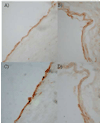Modulation of endothelial cell thrombomodulin by PPAR ligands--variation according to environment
- PMID: 17869327
- PMCID: PMC2577783
- DOI: 10.1016/j.thromres.2007.08.007
Modulation of endothelial cell thrombomodulin by PPAR ligands--variation according to environment
Abstract
Introduction: Thrombomodulin (TM) is an important anti-coagulant protein that is down-regulated on endothelial cells overlying atherosclerotic plaques. We investigated the effects of the peroxisome proliferator-activated receptor (PPAR) ligands, fenofibrate and rosiglitazone, on the expression of TM ex vivo by advanced carotid atheromas, and in vitro by endothelial cells.
Methods: Adjacent carotid atheroma biopsies were incubated in vehicle control or PPAR ligand in explant culture for 4 days. Human aortic endothelial cells were incubated with PPAR ligands in vitro. TM expression was measured by Western blotting and flow cytometry. TM activity was assessed by generation of activated protein C.
Results: The PPAR-alpha activator, fenofibrate, up-regulated total TM expression within carotid explants by 1.7-fold (P<0.001) with no effect on activity. Rosiglitazone treatment had no effect on protein levels but reduced activity by 73% of the control (P<0.05). We noted disparate effects of PPAR ligands in atheroma samples from different patients and postulated that the response of endothelial cells to medication was influenced by the atheromatous environment. Incubation of human aortic endothelial cells with fenofibrate alone led to a dose-dependent increase in TM expression (P<0.05), however, in the presence of oxidized LDL a dose-dependent reduction in TM expression was induced by fenofibrate (P<0.05).
Conclusions: The ability of fenofibrate to increase endothelial cell and carotid atheroma TM protein expression suggests a potential therapeutic role for this medication. The response to PPAR ligands likely varies depending on the exact constituents of individual atherosclerotic plaques, such as the relative amount of oxidized LDL.
Figures








Similar articles
-
Effects of peroxisome proliferator-activated receptor ligands in modulating tissue factor and tissue factor pathway inhibitor in acutely symptomatic carotid atheromas.Stroke. 2007 May;38(5):1501-8. doi: 10.1161/STROKEAHA.106.474791. Epub 2007 Mar 15. Stroke. 2007. PMID: 17363721
-
Evaluation of anti-atherosclerotic activities of PPAR-α, PPAR-γ, and LXR agonists in hyperlipidemic atherosclerosis-susceptible F(1)B hamsters.Atherosclerosis. 2011 Jan;214(1):86-93. doi: 10.1016/j.atherosclerosis.2010.10.033. Epub 2010 Nov 2. Atherosclerosis. 2011. PMID: 21093860
-
Differential effects of peroxisome proliferator activator receptor-alpha and gamma ligands on intimal hyperplasia after balloon catheter-induced vascular injury in Zucker rats.J Cardiovasc Pharmacol Ther. 2003 Dec;8(4):297-305. doi: 10.1177/107424840300800407. J Cardiovasc Pharmacol Ther. 2003. PMID: 14740079
-
Thiazolidinediones up-regulate insulin-like growth factor-1 receptor via a peroxisome proliferator-activated receptor gamma-independent pathway.J Biol Chem. 2010 Nov 19;285(47):36361-8. doi: 10.1074/jbc.M110.137661. Epub 2010 Sep 15. J Biol Chem. 2010. PMID: 20843793 Free PMC article.
-
Expression of heme oxygenase-1 in human vascular cells is regulated by peroxisome proliferator-activated receptors.Arterioscler Thromb Vasc Biol. 2007 Jun;27(6):1276-82. doi: 10.1161/ATVBAHA.107.142638. Epub 2007 Apr 5. Arterioscler Thromb Vasc Biol. 2007. PMID: 17413033
Cited by
-
Classical swine fever virus NS5A protein localizes to endoplasmic reticulum and induces oxidative stress in vascular endothelial cells.Virus Genes. 2012 Oct;45(2):274-82. doi: 10.1007/s11262-012-0773-2. Epub 2012 Jun 21. Virus Genes. 2012. PMID: 22718084
-
The Microvascular and Macrovascular Benefits of Fibrates in Diabetes and the Metabolic Syndrome: A review.Mo Med. 2017 Nov-Dec;114(6):464-471. Mo Med. 2017. PMID: 30228666 Free PMC article. Review.
-
Novel therapeutic targets for preserving a healthy endothelium: strategies for reducing the risk of vascular and cardiovascular disease.Cardiol J. 2011;18(4):352-63. Cardiol J. 2011. PMID: 21769815 Free PMC article. Review.
-
Involvement of Angiotensin II Type 1 and 2 Receptors in Gelatinase Regulation in Human Carotid Atheroma in vitro.J Atheroscler Thromb. 2016 Jul 1;23(7):773-91. doi: 10.5551/jat.31401. Epub 2016 Mar 5. J Atheroscler Thromb. 2016. PMID: 26947595 Free PMC article.
-
Thrombomodulin and its role in inflammation.Semin Immunopathol. 2012 Jan;34(1):107-25. doi: 10.1007/s00281-011-0282-8. Epub 2011 Jul 31. Semin Immunopathol. 2012. PMID: 21805323 Review.
References
-
- Weiler H, Isermann BH. Thrombomodulin. J Thromb Haemost. 2003;1:1515–1524. - PubMed
-
- Seigneur M, Dufourcq P, Conri C, Constans J, Mercie P, Pruvost A, Amiral J, Midy D, Baste J, Boisseau MR. Levels of plasma thrombomodulin are increased in atheromatous arterial disease. Thromb Res. 1993;71:423–431. - PubMed
-
- Gerdes VEA, Kremer Hovinga JA, ten Cate H, Brandjes DPM, Buller HR. Soluble thrombomodulin in patients with established atherosclerosis. J Thromb Haemost. 2004;2:200–201. - PubMed
-
- Wu KK, Aleksic N, Ballantyne CM, Ahn C, Juneja H, Boerwinkle E. Interaction between soluble thrombomodulin and intercellular adhesion molecule-1 in predicting risk of coronary heart disease. Circulation. 2003;107:1729–1732. - PubMed
-
- Suzuki K, Stenflo J, Dahlback B, Teodorsson B. Inactivationof human coagulation factor V by activated protein C. J Biol Chem. 1983;258:1914–1920. - PubMed
Publication types
MeSH terms
Substances
Grants and funding
LinkOut - more resources
Full Text Sources
Medical

